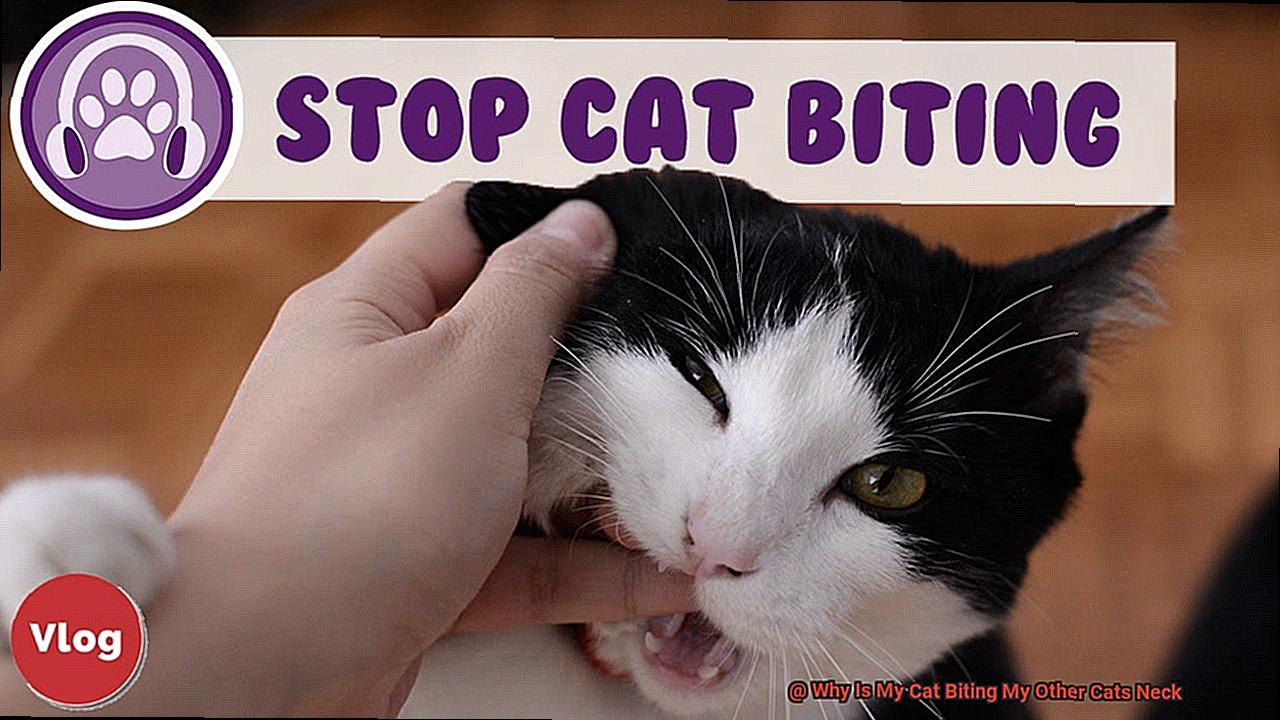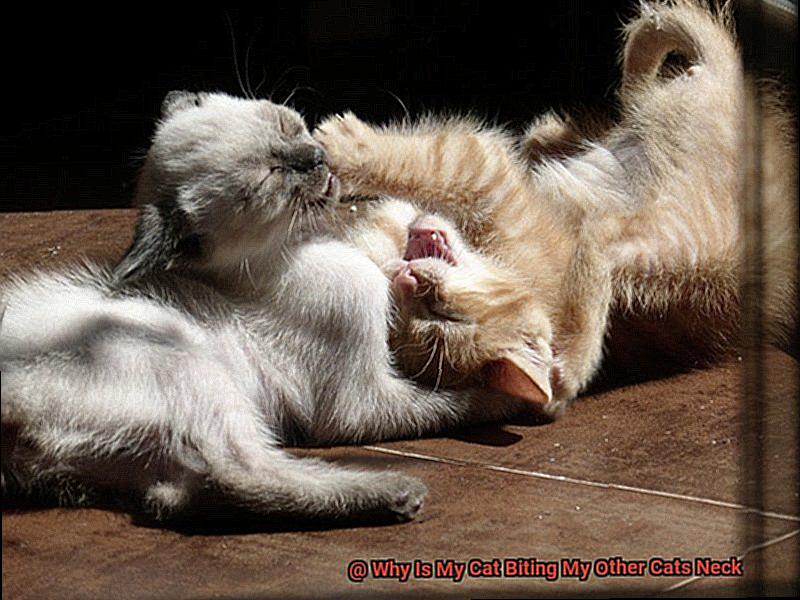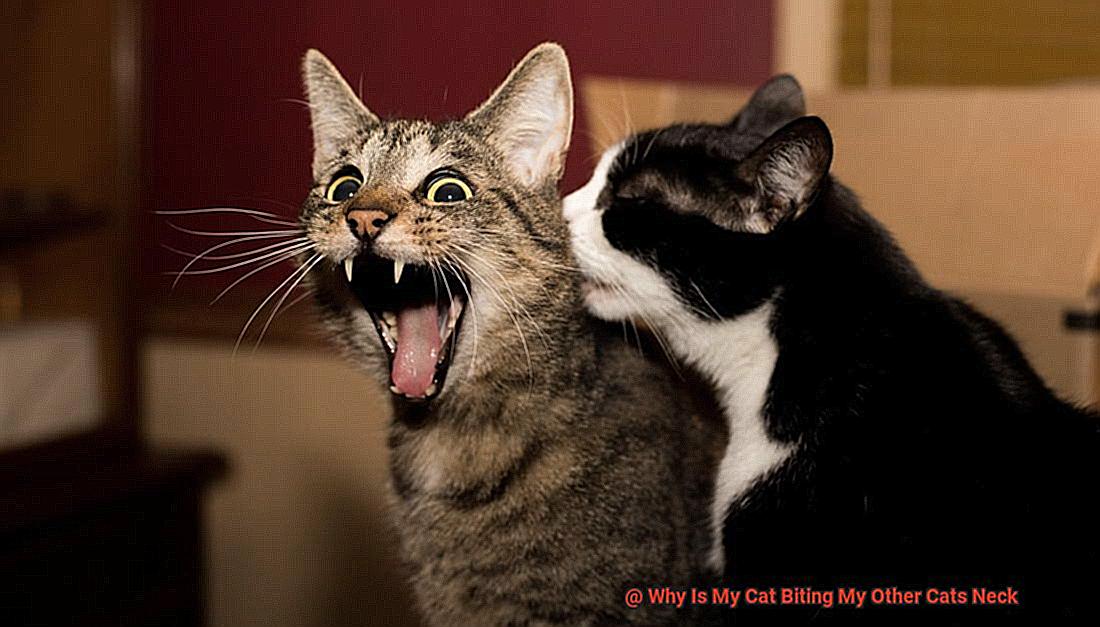Do you ever wonder why your cat is biting the neck of your other cats?
It can be a puzzling and alarming behaviour, but it’s actually quite normal in cats. We’ll explore why cats bite each other’s necks, what it means, and how to handle the issue in this blog post.
The most likely explanation for neck-biting is that your cat is trying to establish dominance over the other cat. Cats are very territorial and use physical contact like neck biting to demonstrate their superiority.
This type of behaviour is especially common when there’s a new cat in the house or when something has changed in the environment or routine. Your cat may also be playing with the other cat in an aggressive way.
Play aggression happens when cats become overly excited during playtime and start biting or scratching each other as part of their game. While this usually doesn’t cause serious injury, it can still be stressful for both cats involved.
Lastly, some cats may bite each other’s necks out of fear or anxiety. If one of your cats feels threatened by another cat, they may resort to aggressive tactics such as biting to protect themselves from perceived danger.
So, keep reading to find out more.
Common Reasons Why Cats Bite Each Other’s Necks
Cats biting each other’s necks is a common behavior that can be alarming for cat owners, but understanding the various reasons behind this behavior is essential for providing a safe and comfortable environment for your cats.
Playful aggression is one of the most common causes of neck biting among cats. When cats play together, they may bite each other’s necks as a way to express dominance or initiate play.
It’s important to keep an eye on their playtime and intervene if it gets too rough and could cause injury to one of the cats. Sexual behavior can also lead to neck biting in cats.
During mating, male cats bite the back of the female cat’s neck in order to immobilize her. This behavior is instinctive and serves as a way of controlling the female during mating.
However, if cats are not spayed or neutered, this behavior can occur even if they don’t intend to mate, resulting in aggressive neck biting. Territorial behavior is another factor that can lead to neck biting among cats.
Cats are naturally territorial animals and they may resort to biting each other’s necks in order to establish dominance or protect their territory. This type of aggressive behavior is more common in male cats and can be triggered by the presence of a new cat in the household or yard.
This type of behavior is more likely seen in timid or shy cats who feel threatened or insecure, and it may require introducing management techniques or consulting with a veterinarian or animal behaviorist if it persists.
Male Cats Biting Female Cats’ Necks During Mating
Male cats biting female cats’ necks during mating is a natural behavior that is essential for the continuation of the feline species.
This behavior is triggered by the male’s mating instincts and hormones, specifically testosterone, allowing him to dominate and mate with the female. The biting of the neck serves as a method of control, keeping the female in place during copulation.
She typically shows signs of submission, such as bending her head down and remaining still, which further encourages successful mating. However, this behavior can be quite aggressive and can result in injuries to the female cat.
If you notice any signs of discomfort or pain in the female cat after mating, it is important to seek veterinary care immediately as this may be an indication of injury or infection. Additionally, if your cat is not in heat or ready to mate, she may become aggressive and resist the male’s advances.
In these cases, it is essential to separate them until she is ready to mate. Understanding why cats bite each other’s necks during mating can help us create a safe and comfortable environment for our feline friends.
Male Cats Biting Other Male Cats’ Necks as a Show of Dominance
This behavior is actually quite common among domestic cats, and it’s a natural instinct for them to do so.
Male cats are territorial by nature and tend to fight over resources such as food, water, and territory. Biting another cat’s neck is a way of establishing one’s power and hierarchy in the home.
It’s important to note that this behavior is different from play aggression, which usually involves playful wrestling, chasing, and pouncing. On the other hand, neck biting often leads to actual fighting.
To address this behavior, it’s important to provide each cat with enough resources such as food, water, and territory to prevent competition and conflict. Additionally, neutering male cats can decrease their territorial tendencies while introducing cats slowly can help establish a peaceful home environment.
How to Tell If the Neck-Biting Behavior Is Aggressive or Playful
Cats often bite each other’s necks, but it can be difficult to tell if the behavior is aggressive or playful. As a cat owner, it’s important to understand the difference in order to maintain a harmonious feline household. Here are some tips on how to tell if your cat’s neck-biting behavior is aggressive or playful.
First, observe your cat’s body language. Cats that are playing will usually have relaxed postures and smooth movements, whereas aggressive cats will have tense postures and stiff movements. Additionally, pay attention to their ears – flat ears indicate aggression, while natural ears suggest playfulness. Facial expressions can also provide clues – dilated pupils and a wrinkled nose usually signify aggression, while closed eyes and a loosened mouth suggest playfulness.
In addition to body language, watch out for other aggressive behaviors such as growling and hissing. Lastly, monitor the intensity of the bites; playful bites are gentle and short-lived, while aggressive bites are forceful and prolonged.
Understanding the difference between playful and aggressive neck-biting behavior in cats is essential for keeping a peaceful feline household. If you notice any signs of aggression from your cat, intervene promptly by distracting them with toys or treats or separating them from the other cats temporarily.
The Impact of Cat-on-Cat Aggression on Pet Well Being
Cat-on-cat aggression can have a devastating impact on pet well-being, leading to physical and emotional distress.
Cat owners must be vigilant in recognizing the signs of aggression and take proactive steps to prevent it. The physical effects of cat-on-cat aggression can range from minor scratches to more serious open wounds that require medical treatment.
Additionally, the victim cat may experience anxiety, fear, and stress due to constant exposure to violence, which can lead to other behavioral issues such as marking or urinating outside the litter box. Fortunately, there are several measures that cat owners can take to reduce the risk of cat-on-cat aggression in their households.
These include separating cats during meal times, providing multiple feeding stations, and ensuring there are enough litter boxes for all cats. It is also important to provide ample toys and space for each cat so they can engage in individual play and activities.
Tips for Creating a Safe and Comfortable Environment for Your Pets
Creating a safe and comfortable environment for your pets is essential for their overall wellbeing. Not only does it ensure that they are healthy and happy, but it also helps prevent any aggressive behavior between them. Here are five tips to ensure your cats have the perfect environment:
Provide ample space
Cats need their own personal space, especially if you have multiple cats. Make sure to provide separate beds, hiding spots, and scratching posts so that each cat can stretch out and relax without feeling threatened.
Keep the litter box clean

Cats are very particular about their litter box, so make sure to sweep it regularly and provide separate boxes if you have more than one cat. This will help avoid any competition over resources or territories that could lead to aggressive conduct.
Multiple feeding stations
Food is another thing that cats can be territorial over, so make sure each cat has their own bowl in specific areas of the house. This will help them avoid fighting each other for food and minimize any potential bullying between them.
Provide vertical space
Cats love to climb and explore, so providing cat trees or shelves will give them an elevated area where they can feel safe and protected from other cats in the household.
Separate aggressive cats
If one cat is adamant against another, consider using baby gates or separate rooms for each cat until the problem is addressed.
What To Do If You Notice Your Cat Biting Another Cat’s Neck
If you notice your cat biting another cat’s neck, it is essential to take swift action to prevent further escalation. Here are five steps you can take to address this behavior and create a more peaceful environment for all your pets.
Separate the Cats

The first step should always be to separate the cats as soon as possible. Whether you physically remove one from the situation or create a barrier between them, this helps prevent any further aggression or harm.

Observe the Behavior

Once the cats are separated, it’s essential to observe their behavior before reintroducing them. This will give you a better understanding of what may have triggered the biting and how to address it.

Consider the Environment
Cats may become territorial, stressed, or fearful in certain environments. Assess the physical space and see if there are any stressors, such as a lack of resources, too many cats in one space, or other disruptions that could be contributing to the biting behavior.
Address the Underlying Issue
In many cases, a cat’s biting behavior towards another feline is rooted in an underlying issue such as anxiety, fear, or a medical condition. Addressing the root cause can help alleviate the biting behavior.
Reintroduce the Cats
Once you feel comfortable reintroducing the cats, make sure to do so slowly and under close supervision. Provide plenty of resources, such as food and water bowls, litter boxes, and toys, to reduce competition and potential stressors.
YIr3EYBf4pQ” >
When to Seek Professional Help from a Veterinarian or Animal Behaviorist
Cats biting each other’s neck is not something to be taken lightly.
This behavior can indicate aggression, territorial issues, or stress and anxiety, and if left unchecked, could lead to serious injury. If you’re seeing this kind of behaviour in your cats, it’s important to seek professional help from a veterinarian or animal behaviorist as soon as possible.

A veterinarian can identify any underlying health issues that may be causing the aggression and provide medical attention if necessary. An animal behaviorist can develop a plan to address the root cause of the aggression and provide tips on how to stop the biting behavior and improve your cats’ relationship.
Time is of the essence when seeking professional help – delaying could make it more difficult for your cats to learn new behaviors and may even result in them being permanently separated.
Also Read: Why Does My Kitten Attack My Face? – 21Cats.org
Conclusion
Cat-on-cat combat can be alarming, but understanding the causes of neck-biting behaviour is the key to creating a safe and secure environment for cats.
Most often, it’s playful assault, sexual conduct or territorial disputes that trigger this behaviour. Playful assaults are usually harmless, but should still be monitored.
Male cats may even bite female cats’ necks during mating to immobilize her. In addition, male cats may bite each other’s necks as a sign of power or protection of their territory.
It can be difficult to distinguish between offensive and playful neck-biting activity. Cat owners should look out for loosening postures and smooth movements that suggest playfulness rather than rigid postures and stiff movements that indicate aggression.
If you find your cat biting another cat’s neck, take swift action by separating them immediately and seeking expert assistance from a veterinarian or animal behaviorist if necessary.







